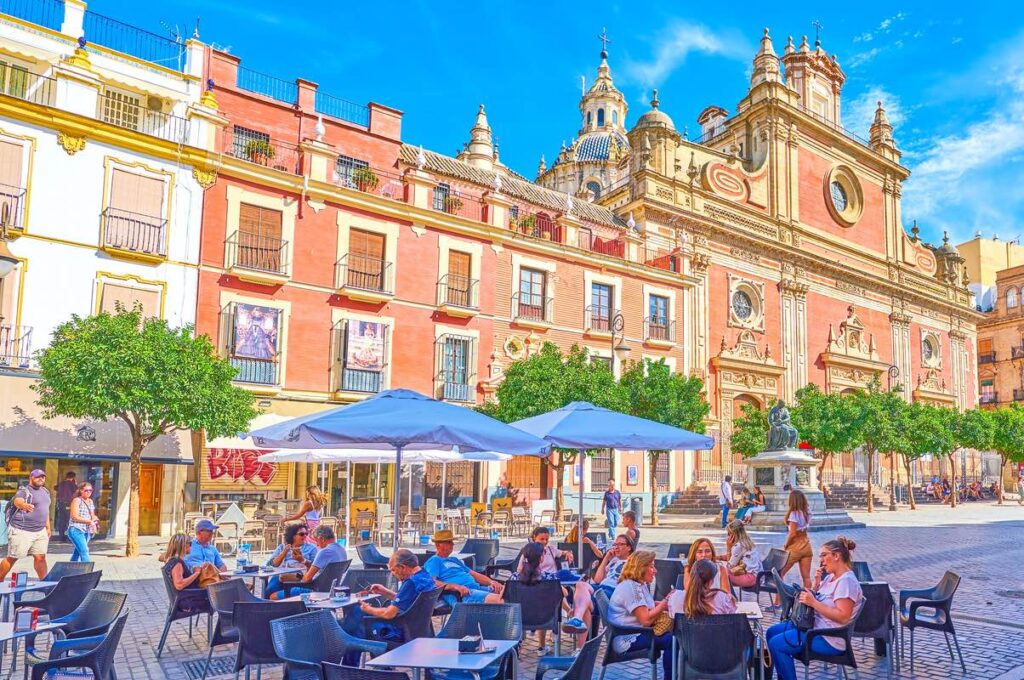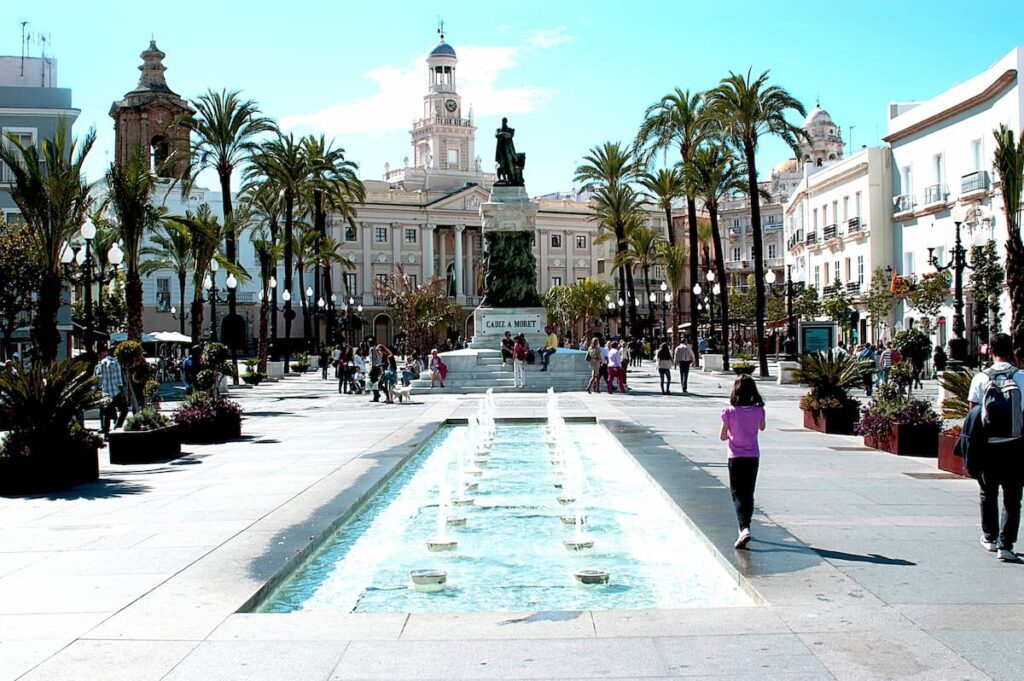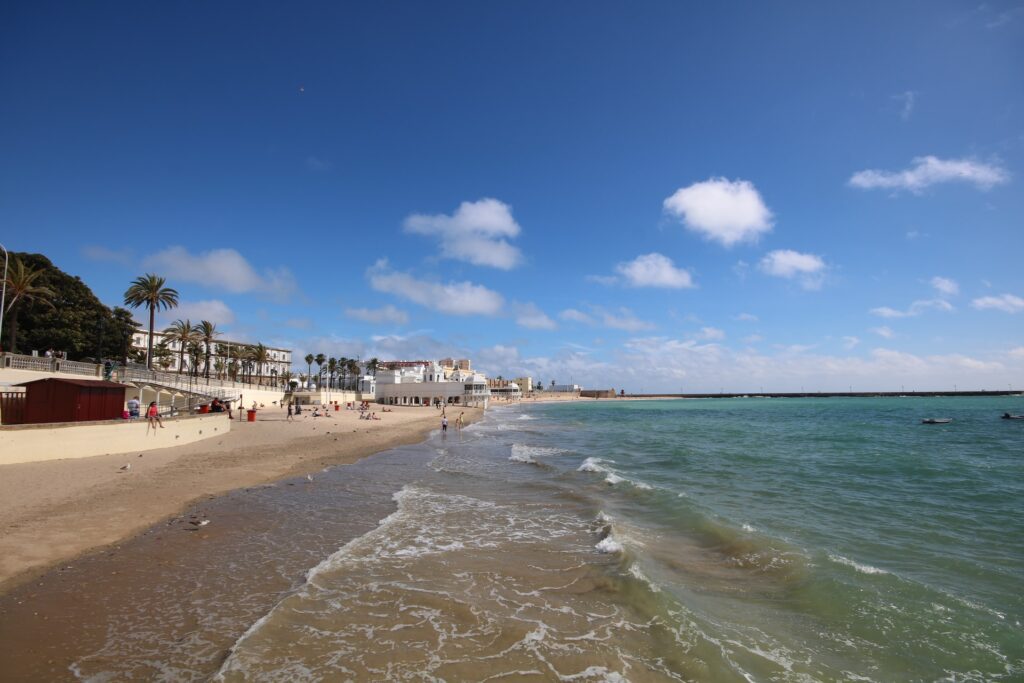Cadiz Travel Guide
This article may contain affiliate/compensated links. For full information, please see our disclaimer here.
When talking about the top destinations in Andalucia, Seville and Granada are the cities that immediately come to mind. But there’s an Andalucian port city that still remains under the radar: Cádiz.
This city is full of historic charm, gorgeous beaches, and fun activities that make for an unforgettable holiday. I didn’t know much about Cádiz before I visited and I was so pleasantly surprised by how much the city has to offer!
Read on to learn more about the beautiful city of Cádiz and get essential travel tips so that you can make the most of your time here.
Cadiz Facts and Figures
Here are some interesting facts about this seaside city in Andalucia.
- Cádiz is considered the oldest continuously inhabited city in Western Europe, with a history dating back more than 3,000 years.
- The city was originally founded by the Phoenicians around 1100 BC and was known as Gadir. Its strategic location made it an important trading hub in the ancient Mediterranean.
- Located on a narrow peninsula, Cádiz is surrounded by the Atlantic Ocean and the Bay of Cádiz.
- The city played a significant role in Spain’s exploration and colonization of the Americas during the Age of Discovery. It served as a major port and departure point for many expeditions.
- Cádiz hosts one of Spain’s most famous carnival celebrations. The Carnival of Cádiz is renowned for its lively atmosphere, music, and satirical performances known as chirigotas.
- Cádiz boasts beautiful beaches along its coastline, including La Caleta, Santa María del Mar, and Playa de la Victoria. The beaches are known for their golden sand and crystal-clear waters.
- The Cathedral of Cádiz, also known as the Cathedral of Santa Cruz, is a stunning architectural masterpiece and one of the city’s main landmarks. It took over 100 years to complete.
- The renowned composer and pianist Manuel de Falla was born in Cádiz. He is considered one of Spain’s greatest musicians and is known for his influential works.
- Cádiz is famous for its seafood dishes. Some local delicacies include fried fish (pescaíto frito), seafood rice (arroz de marisco), and shrimp tortillas (tortillitas de camarones).
- Cádiz is part of the Sherry Triangle, an area known for producing sherry wine. The city is home to several renowned sherry bodegas where visitors can taste and learn about this unique fortified wine.
- The city is known for its Monument to the Constitution of 1812, a neoclassical structure honoring the Spanish constitution of that year. It is a symbol of Cádiz’s historical significance.
- Calling all “Game of Thrones” fans! Some GoT scenes were filmed in Cádiz, particularly in the nearby town of Tarifa, which served as the location for the city of Dorne.

Visiting Cadiz, Spain: Travel Tips
Here’s what you need to know to plan your trip to Cadiz.
How to Get to Cadiz
As one of the major cities in Andalucia, there are various options available on how to get to Cadiz. The best way to get there depends on various factors such as your starting destination, budget, travel style, and how much time you have. So after reading through the options below, I suggest doing some of your own research to find what works best for you.
By Plane
Cadiz doesn’t have its own airport but you can fly into either Seville airport or the airport at Jerez de la Frontera.
Seville airport (SVQ) serves both international and domestic flights and it’s a major hub in Andalucia so it’ll likely be the better option if you’re arriving from outside of Spain. From there, you get a rental car and drive to Cadiz or take the bus or train. From Seville to Cadiz, the journey is up to 2 hours.
Jerez Airport is nearer to Cadiz, only about 45 minutes away from the city center. But it’s more of a regional airport and serves fewer international flights. It mainly offers flights to select European destinations, particularly during the peak tourist season. Once you arrive at the airport, you can take a taxi or a bus to Cadiz. The bus ride takes about an hour and costs around €5.
By Train
If you’re already in Spain, the train could be a quick and comfortable way to get to Cadiz. The train station in Cadiz is located in the city center, making it easy to get to your final destination.
Here are some approximate travel times for reference:
- The train ride from Madrid takes about 4 to 5 hours and you’ll typically need to switch trains in Seville
- From Seville to Cadiz, a train journey usually takes about 1.5 hours
- There are direct train services from Cadiz to Malaga which take approximately 3 to 4 hours
Tip: Travel times may vary depending on the specific train service, departure time, and any connections involved. It’s always best to check schedules and book your tickets in advance to ensure a smooth and efficient journey to Seville. Typically, tickets are available up to 4 months before your travel date. Head to the Renfe website (be sure to toggle to the English language for easy navigation) to search for your routes.
By Bus
Getting to Cadiz by bus is also a viable option. There are several public bus lines that connect the city with other major cities in Andalucia, such as Seville, Malaga, and Algeciras. The bus station for coaches to other cities in Andalucia and other towns in the area of the Bay of Cadiz is located near the entrance to the old-walled city to the east overlooking Cadiz Bay.
You can search for and buy bus tickets online and the bus company will depend on your departing destination. ALSA, which runs services across Spain, is a good place to check first.
Here are some estimated travel times for bus journeys to Cadiz, for reference (actual travel times can vary based on bus company, routes etc):
- Bus from Madrid to Cadiz: The travel time from Madrid to Cadiz by bus is approximately 6 hours and 10 minutes. The journey covers a distance of 487 km (302 miles).
- Bus from Seville to Cadiz: The travel time from Seville to Cadiz by bus is approximately 1 hour and 45 minutes. The journey covers a distance of 113 km (70 miles).
- Bus from Malaga to Cadiz: The travel time from Malaga to Cadiz by bus is approximately 4 hours and 30 minutes. The journey covers a distance of 269 km (167 miles).
- Bus from Barcelona to Cadiz: The travel time from Barcelona to Cadiz by bus is approximately 16 hours and 30 minutes. The journey covers a distance of 1278 km (794 miles).
Always compare the price of a bus ticket with the price of a train ticket. The bus is typically cheaper but the trade-off is that the journey may be longer.
Travelling between Cadiz and Seville? Check out our detailed Cadiz-Seville transport guide for all the essential information to plan your journey!
By Car
If you prefer the flexibility of having your own wheels, you can rent a car at the airport or in the city center. The drive from Jerez Airport to Cadiz takes about 45 minutes, while the drive from Seville takes about 1.5 hours.
I’ve done the drive from Seville to Cadiz and found it very pleasant. The highways are well-marked and well-maintained, making it an easy journey.
Do note that parking in the city center can be difficult, so I suggest parking outside the city as it’s cheaper and easier. You can then take public transportation or walk to your destination.
Tip: A good parking spot is the ferry terminal/port where the cruise ships dock. There’s ample parking here, it’s reasonably priced, and it’s not too far a walk to the Old Town. We used this parking lot during our stay in Cadiz and found that it was a good deal! Here’s the approximate GoogleMaps location.
Getting Around Cadiz
Once you’re in Cadiz, getting around the city is easy. The historical sights are concentrated within the historic center so it’s best to simply walk around on foot. Walking around the city will allow you to fully appreciate its stunning architecture and charming streets. If you have more than a day here, you can also plan your daily itinerary to focus on specific areas so that you’re not exhausted from all the walking.
During my stay in Cadiz, we simply walked everywhere! It’s a great way to get to know a place as well as discover little hidden gems or small restaurants and cafes that I wouldn’t have found otherwise.
Another option for getting around Cadiz is by bike. The city has a bike-sharing program that allows you to rent a bike for a small fee. There are also several bike rental shops throughout the city. Biking is a great way to explore the city at your own pace and get some exercise at the same time.
Buses in Cadiz
Cadiz has a reliable bus system with 5 lines that connects all the major neighborhoods and attractions, including the nearby beaches! Most of the routes begin in the city center in Plaza España.
Bus tickets can be purchased directly from the driver upon boarding and the fare is based on the distance travelled, with different zones and pricing categories. You can also buy a ‘Bonobus’ from newsagent kiosks for 7€ for ten journeys.
Cádiz also operates a night bus service, known as “Buho” buses, which run during the late evening and early morning hours. These buses provide transportation options for those travelling at night or attending events and festivities.
You can get more information on buses in Cadiz at the bus stops or download the map of bus routes here.
Taxis in Cadiz
It’s unlikely you will need one but if you do, taxis are readily available in Cadiz especially in busy areas such as the city center, transportation hubs, and popular tourist spots
Taxis in Cádiz charge fares based on a combination of distance travelled and time spent in the taxi. The fare consists of a starting fee (banderilla) and an additional fee per kilometer or minute. There may also be extra charges for luggage or travelling during nighttime hours.
There are taxi stands located throughout the city and you can also flag down a taxi on the street. Taxis in Cadiz are generally safe and reliable, but it’s a good idea to only use licensed taxis, check the meter is running, and keep your belongings with you at all times. I also recommend having the address or destination written down to ensure clear communication.
Driving in Cadiz
While it’s not necessary to have a car to get around Cadiz, it can be a good option if you’re travelling in a group or simply want more freedom and flexibility. Driving will also allow you to travel to the small towns and beaches outside of the Cadiz city center.
That said, driving within the city center can be challenging due to narrow streets and limited parking so I would not recommend doing so. As mentioned above, it’s best to park your car outside the city center and take public transportation or walk to your destination.
Best Time to Go to Cadiz
If you’re visiting Cadiz for its beautiful beaches, then summer is the best time to go to Cadiz. July and August are the hottest months in Cadiz, with an average temperature of 28°C (82°F) in August. So if hanging out at the beach and doing outdoor activities are your thing, summer is for you!
Want to avoid the huge crowds and enjoy a more peaceful trip? Then you might want to consider going o Cadiz in winter. Due to its location, the winters in Cadiz are mild and pleasant so you can still have a great time enjoying the city during this time. I’ve been to Cadiz in winter and had a wonderful time! You can learn more about what to expect on a winter trip to Cadiz here.
For the best of both worlds, great weather and a lively atmosphere, you can’t beat the shoulder seasons in Cadiz (March to May and September to November). In my opinion, the shoulder seasons of spring and fall offer a good balance of pleasant weather, fewer crowds, and vibrant local events.
Learn more about the best time to visit Cadiz in this article.
How Many Days to Spend in Cadiz?
The number of days to spend in Cádiz depends on various factors, including your interests, available time, and the pace at which you prefer to explore. Based on my personal experience, I recommend spending at least two to three days in Cádiz to fully experience its highlights and immerse yourself in its unique atmosphere.
If you’re planning a beach holiday, you may want to allocate more time to explore the beautiful beaches near Cadiz which are certainly worth discovering.
What if you’re short on time? You can still see the city’s main highlights in 1 to 2 days but it will be a tight squeeze and you should focus on the must-see attractions in Cadiz. Check out our Cadiz day trip guide here.
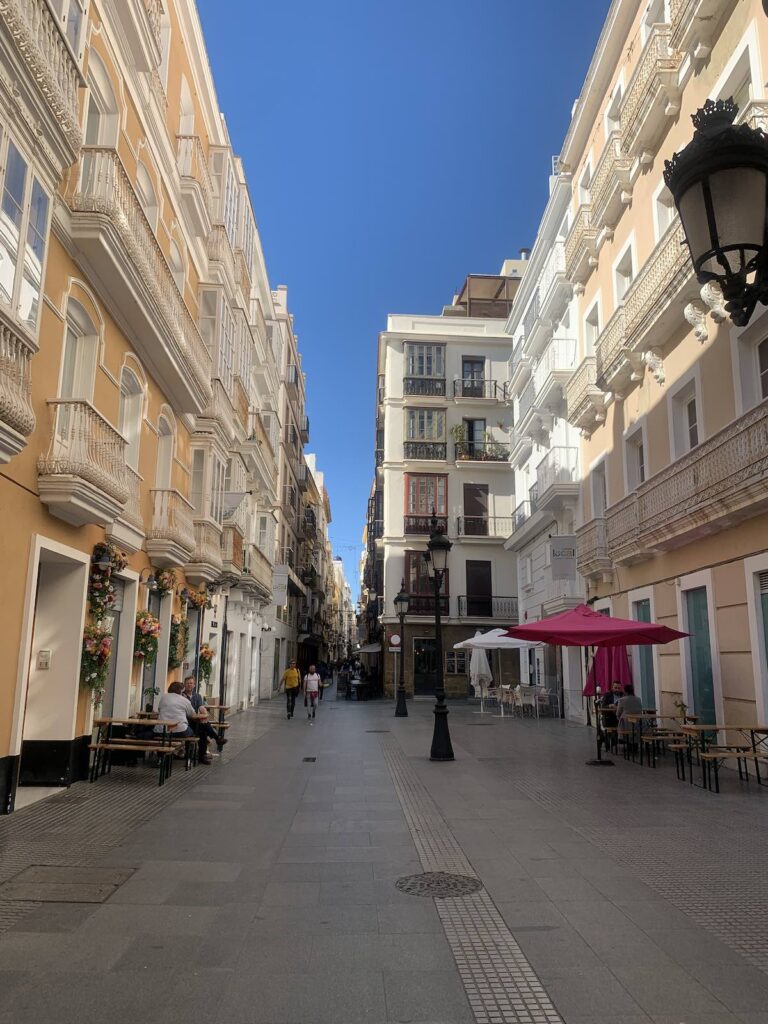
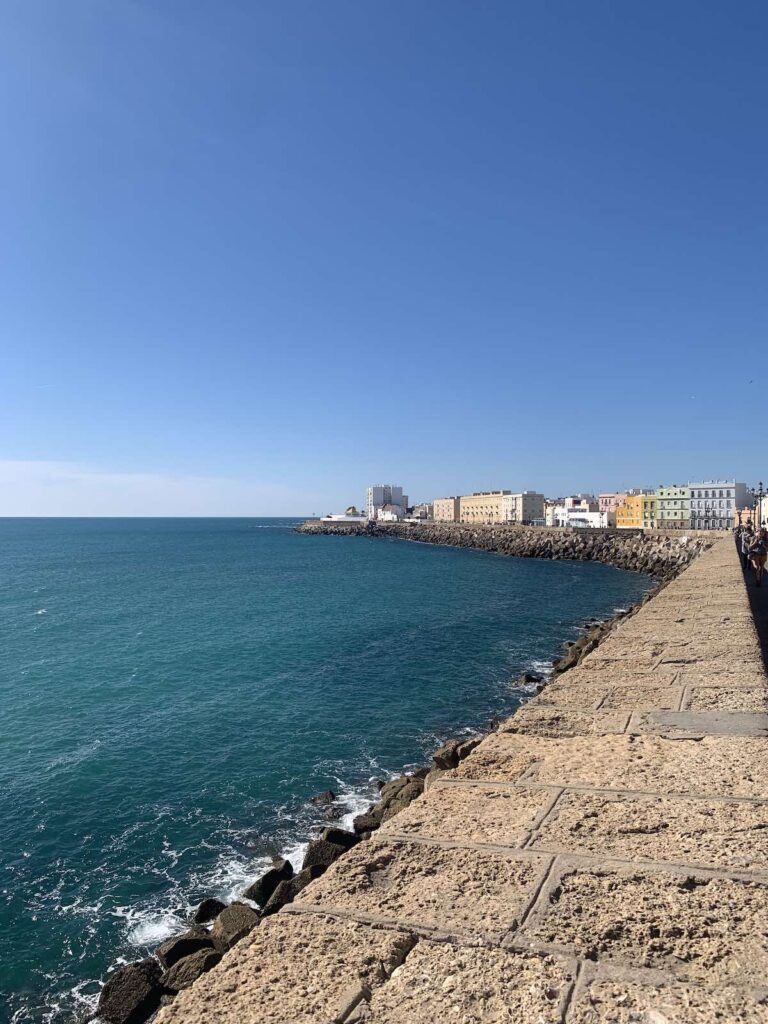

What to Do in Cadiz, Spain
Now let’s get into the fun part! Here’s a brief overview of the top 10 things to do in Cadiz.
- Visit the Cathedral of Cadiz: The Cathedral of Cadiz is one of the most iconic landmarks in the city. It is a stunning example of Baroque architecture and features a beautiful interior with intricate details and artwork.
- Explore the Old Town: Stroll in the Old Town of Cadiz, a maze of narrow streets and charming plazas. It’s a great place to wander around and discover hidden gems, such as small shops, cafes, and historic buildings.
- Dive into Cadiz’s Roman Past: Cadiz’s history as a Roman city comes to life at its well-preserved Roman theatre. This is a must-see attraction and it’s free!
- Relax on the Beaches: Cadiz is known for its beautiful beaches, such as Playa de la Caleta and Playa Victoria. These beaches are perfect for swimming, sunbathing, and relaxing. Click here to read more about the beaches in Cadiz.
- Visit the Torre Tavira: The Torre Tavira is a historic watchtower that offers stunning views of the city and the surrounding area. It also features a camera obscura, which projects a live image of the city onto a screen inside the tower.
- Explore the Castle of San Sebastian: The Castle of San Sebastian is a historic fortress located on a small island off the coast of Cadiz. It is accessible by foot during low tide and offers stunning views of the city and the sea.
- Discover the Fish Market: The Mercado Central de Abastos is a bustling fish market located in the heart of Cadiz. It’s a great place to experience the local culture and sample fresh seafood.
- Visit the Museum of Cadiz: The Museum of Cadiz is home to a vast collection of art and artefacts that showcase the city’s rich history and culture. It’s a great place to learn about the city’s past and present.
- Enjoy the local cuisine: Cadiz is known for its delicious seafood dishes, such as fried fish, grilled octopus, and seafood paella. There are also several local specialities, such as tortillitas de camarones (shrimp fritters) and chicharrones (pork cracklings).
- Take a Day Trip to Jerez: Jerez is a nearby city that is known for its sherry wine and equestrian traditions. It’s a great place to explore the local culture and sample some of the region’s finest wines.
These top 10 attractions activities will give you a good sense of the city’s charms and you can easily cover them in 3 to 4 days! For more details, check out our post on what to do in Cadiz.
Have more time? You can fill your itinerary with these amazing day trips from Cadiz.
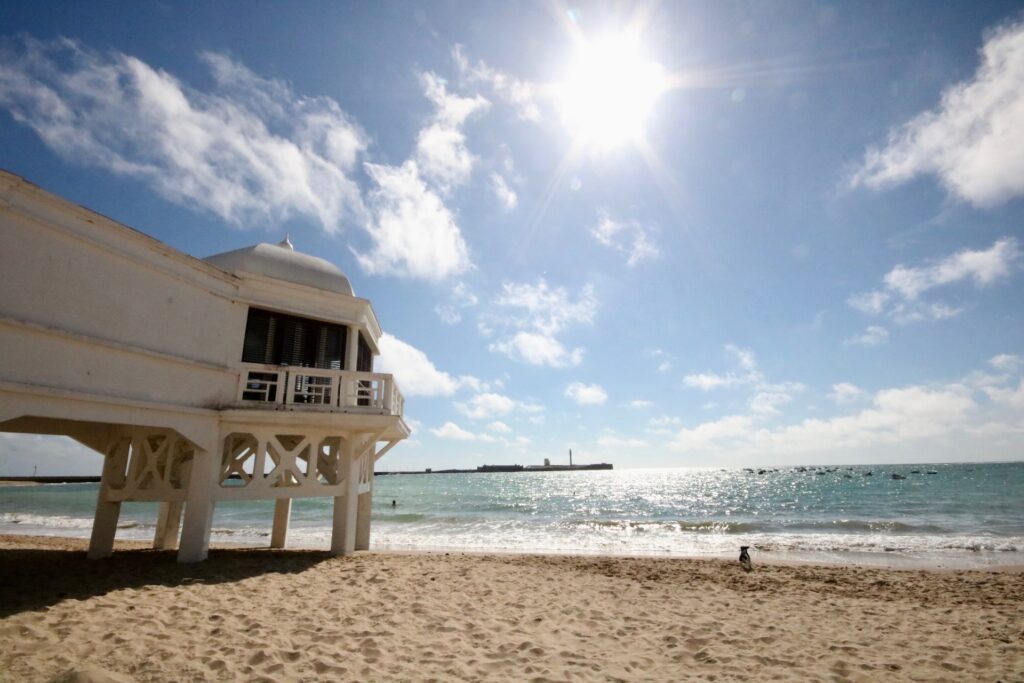
Recommended Tours & Activities in Cadiz
- I love walking tours and taking one in Cadiz is an awesome way to get to know the city and learn its history. I like using Guruwalk to look for free walking tours that fit my interests and schedule.
- Prefer to explore on 2 wheels? Then a Cadiz bike tour could be the thing for you. Or try this Segway history tour of Cadiz.
- For an unforgettable travel memory, book a sunset beach ride on horseback in Cadiz!
- Get introduced to the local food scene in this 3-hour tapas tour (yum yum!)
- Experience Cadiz in a new way with a private boat trip in Cadiz Bay where you can choose to go fishing, have a sunset cruise or simply sail around.
- If you have time to spare, then consider taking a day trip to Gibraltar.

Festivals in Cadiz, Spain
Throughout the year, Cádiz comes alive with a variety of traditional and cultural celebrations that showcase the city’s unique spirit. From extravagant carnivals to religious processions, these festivals provide an unforgettable experience for locals and visitors alike.
Let’s dive into some of the best festivals in Cádiz.
Carnival of Cádiz
The Carnival of Cádiz is the city’s most famous and eagerly anticipated festival. Held in the weeks leading up to Lent, this carnival is renowned for its exuberant atmosphere, vibrant costumes, and satirical performances.
Many Spanish cities celebrate Carnival but Cadiz has puts its own spin on it. During this festival, the streets of Cádiz become a stage for musical groups known as chirigotas, who entertain crowds with humorous songs and witty social commentary.
The carnival’s energy is infectious, drawing visitors from all over the world to join in the festivities and experience the true essence of Cádiz. So if you’re visiting in February, pack your costumes and get ready to party on the streets of Cadiz!
Semana Santa (Holy Week)
As a deeply rooted Catholic city, Cádiz celebrates Semana Santa with great devotion and solemnity. This week-long religious event takes place in the spring, leading up to Easter Sunday. Elaborate processions fill the streets, with participants dressed in traditional robes and carrying ornate religious statues. The processions create a somber and reflective ambience, and the streets are adorned with flowers and incense. Observing the Holy Week processions in Cádiz offers a unique opportunity to witness the city’s religious devotion and experience a centuries-old tradition.
Cadiz Music Festival
The Cadiz Music Festival, also known as the Concert Music Festival, is a month-long event that takes place in July. The festival attracts thousands of music lovers from around the world, who come to hear performances by world-renowned musicians and orchestras. The festival’s program includes a wide range of musical genres, from classical to jazz and pop.
The festival is held in the Poblado de Sancti Petri, a picturesque village located on the coast of Cadiz. The village is home to a medieval castle and a beautiful beach, making it a perfect setting for outdoor concerts.
In addition to the main concerts, the festival also features workshops, masterclasses, and talks by musicians and music experts. There are also opportunities to meet the musicians and attend post-concert receptions.
The Cadiz Music Festival is a must-see event for music lovers, and is a great way to experience the beauty and culture of Cadiz.
Click here for more information on the music festival.
Tip: Things get busy in Cadiz during festivals so if you’re planning a visit during one of these times, it’s a good idea to book your accommodation in advance.

What to Eat in Cadiz
I love discovering a city through its food and it’s always fun to try local specialties. In Cadiz, you’ll find the usual Spanish faves as well as regional and local dishes. Cadiz’s location by the sea means that seafood is a big part of their diet and why not, as it’s especially fresh here! The seafood I ate here was super delicious.
Here are some must-try local foods and dishes in Cadiz:
- Fried Fish: Cadiz is known for its delicious fried fish, which is typically made with fresh local catch such as sardines, anchovies, and squid. The fish is coated in a light batter, fried until crispy and then served with lemon wedges. Pair it with a cerveza and you’re set!
- Seafood Paella: While paella originated in Valencia, it’s also a staple in Cadiz. The seafood paella in Cadiz is made with fresh seafood such as prawns, mussels, and clams, and is flavored with saffron and other spices.
- Chicharrones: How does crispy pork belly sound? Chicharrones are made by frying pork belly until crispy and then seasoning it with salt and paprika. They’re a popular snack and often served as a tapa with a cold beer or sherry.
- Tortillitas de Camarones: Tortillitas de Camarones are small shrimp fritters that are a speciality in Cadiz. They are made by mixing shrimp, flour, and other ingredients into a batter and then frying them until crispy. So good!
- Atun Rojo de Cadiz: Atun Rojo de Cadiz is bluefin tuna that is caught off the coast of Cadiz during the almadraba season. It’s a delicacy in the region and is often served raw as sushi or sashimi, or grilled with olive oil and garlic.
- Gazpacho: This cold soup is a refreshing dish on a hot day! Made with tomatoes, peppers, cucumbers, and other vegetables, it’s often served with croutons or diced vegetables on top.
- Huevos a la Flamenca: Huevos a la Flamenca is a traditional Andalucian dish that is popular in Cadiz. It’s made with eggs, tomatoes, peppers, and chorizo, and is baked in a clay dish until the eggs are set
So keep an eye out for these food items when you’re eating out and give them a try!


